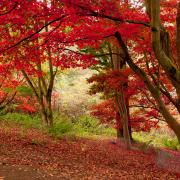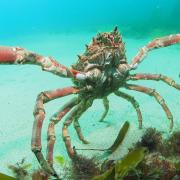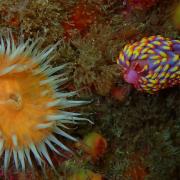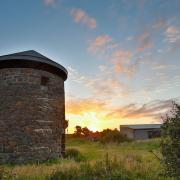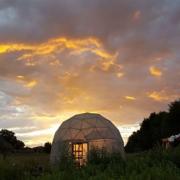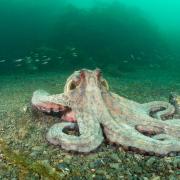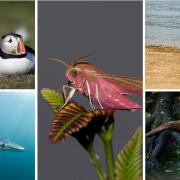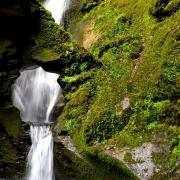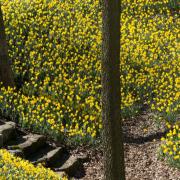In this January issue we talk to a Cornwall Wildlife Trust Reserve Manager about his top five wildlife encounters in the county
Callum Deveney, Reserves Manager at Cornwall Wildlife Trust, reveals his top five mammal encounters at some of the Trust's nature reserves
As most of you probably know, seeing native mammals in the wild is more a question of luck than judgement - being in the right place at the right time. What I enjoy about walking in the countryside is that there is always a chance you might see something special. Read on to hear about my 'top five' mammal encounters on Cornwall Wildlife Trust nature reserves.
Cabilla & Redrice Woods
Having already said that seeing mammals is largely a matter of chance, a visit to Cabilla & Redrice Woods will shorten the odds as there is a good list of mammals present including deer, badger, otter, fox, dormouse and other small mammals, as well as a number of bat species. My favourite encounter at Cabilla was with none of the above but came about while doing some tree-felling deep in the woods.
After a morning of felling, my chainsaw needed sharpening, so I stopped to file the teeth on the saw. This action produces a high-pitched squealing noise and after a few minutes of filing I noticed some movement in the undergrowth near to where I was working. I soon realised I had been joined by a weasel who, in all likelihood, mistook the sound of my file as an animal in distress, perhaps a squealing rabbit. I have heard that blowing on a blade of grass between your thumbs can have the same result!
Five Acres
Working at the Cornwall Wildlife Trust headquarters at Allet brings me into daily contact with staff from other departments, and my colleagues at the Environmental Record Centre for Cornwall and the Isles of Scilly (ERCCIS) are always reminding me to record all the mammals I see. It's amazing how under-recorded mammals are in Cornwall and how little we know about some species.
While on the phone one day in my office I noticed a small mammal in the undergrowth outside the office window. It was definitely a shrew, but its markings (white underside, black on top) made me curious as to whether it might be a water shrew.
Remembering that my colleagues at ERCCIS had told me that water shrews were under-recorded, I finished my phone call and armed with a butterfly net left my office and carefully captured the shrew. Seeing it up close I was certain it was a water shrew, but on this occasion I was able to take my record into ERCCIS for a positive identification. I then released the shrew back where I had found it and watched it scurry safely back into the undergrowth.
Description
At the two-hectare headquarters of the Cornwall Wildlife Trust, there is a small demonstration reserve with mixed woodland, a wildlife garden, ponds and an outdoor education area. A short walk away is an area of wetland in a valley bottom with the rare plant, Dorset heath.
Directions
Take the B3284 north from Truro and fork right (signposted to Perranporth) at the junction in Allet.
Five Acres is immediately on the right.
Windmill Farm
One record I nearly missed was a rabbit at Windmill Farm. While walking through the long grass of a hay meadow with some colleagues we noticed a fox making its way around the edge of the field. Just as we stopped to admire the fox we startled a rabbit from beneath our feet. With the long grass and, for the rabbit, the wrong wind direction, we watched in amazement as the rabbit ran to exactly the spot where the fox was standing. Without having to move a muscle other than its jaw, the fox took the rabbit. We wondered if this was nature's equivalent of fast food!
Description
This 75-hectare reserve is a mixture of grassland and heathland of international importance. Formerly a dairy farm, areas of pasture are now being managed to attract a variety of wildlife with the creation of hay meadows, arable fields, ponds and wetland areas.
Directions
The reserve is about 1 mile (1.6km) north of Lizard village, with access from the A3083. Turn right going towards Lizard village at the 'Wild Camping' sign and follow the lane until you see the windmill.
St George's Island
Whereas Cabilla & Redrice Woods is a short-odds bet for seeing mammals, St George's Island is a real long-shot. In fact, we know that other than rats there are no mammals on the island. Imagine my surprise then, when last summer the warden phoned me to say he'd seen a roe deer in the woods. 'The woods' is perhaps too grand an expression for the few trees on St George's Island, but sure enough this deer had swam across from the mainland (approximately half a mile) to explore the island. A few days later, having encountered no other mammals, especially deer, it swam back to the mainland.
Description
The nine-hecatre island is a marine nature reserve and the waters around it are teeming with natural life. It provides a quiet haven for wildlife, with a variety of habitats including woodland, maritime grassland, sand, shingle and rocky reef.
Directions
From Easter to September it is possible to get a boat to the island from East Looe. The boat can only land on the island three hours either side of high tide and it will not operate in rough sea conditions.
Churchtown Farm
I mentioned bats at Cabilla, which at dusk you can see leaving their roosts in the mine adits. At Churchtown Farm I spent an evening being bombarded by three different species of bats - pipistrelle, noctule and lesser horseshoe.
Churchtown Farm has wonderful thick hedges and these are used by the bats for feeding and navigation. One evening a few summers ago the warden was leading a guided walk and we finished up at dusk standing at the point where three hedgerows converge. We were treated to an aerial display of bats diving and swirling around our heads, sometimes getting so close you felt they would crash into you.
Description
The 61-hectare reserve has a picturesque setting between the Tamar and the Lynher estuaries. The majority of habitat is farmland, which is now managed for wildlife, and includes wetland, hay meadows, arable land and hedgerows. There is access to inter-tidal mudflats and quarries with geological interest.
Directions
Locate Saltash College. At the junction with St Stephen's Road, turn left and follow the road until the next junction. Turn right down Wearde Road, and pass the school. The reserve entrance is found a few hundred yards further along the road on the right, down an old trackway.
I'm sure that everyone who visits nature reserves has similar stories and, like me, enjoys these chance encounters. Our nature reserves are a haven for mammals and this is one of the many reasons to visit them.
If you don't have a Reserves leaflet telling you where they are and how to get to them, please contact Cornwall Wildlife Trust, Five Acres,
Allet, Truro, TR4 9DJ. (01872) 273939,
www.cornwallwildlifetrust.org.uk.
If you do see any mammals when you're out and about please send your records to ERCCIS (01872) 240777, www.erccis.co.uk.







